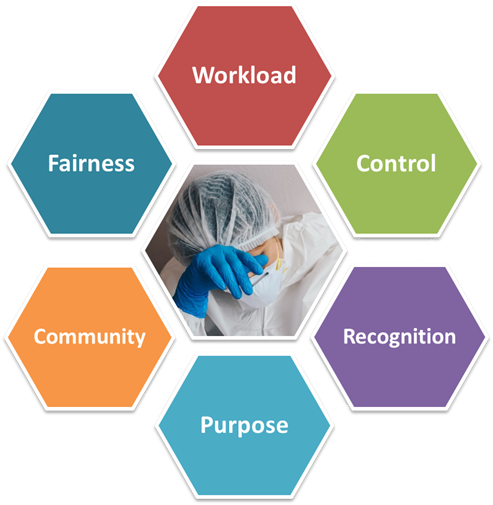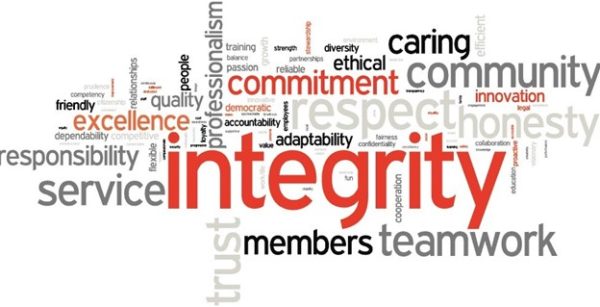LeaderBriefing
Understanding the root causes of burnout is Step One in solving this growing crisis

Early in the COVID-19 crisis, all efforts were focused on dealing with the immediate, daunting issues facing healthcare providers: bed capacity, adequate personal protective equipment (PPE), drug and vaccine research … and literally, surviving day-to-day.
But while the spotlight was shining brightly on these critical issues, a growing, serious problem has been lurking in the shadows. In healthcare provider organizations, the underlying work and social environment either was helping caregivers effectively, collaboratively, and rationally deal with the crisis, or it was exacerbating stress and challenges.
 Healthcare organizations are learning that burnout is a problem that is both widespread and affects more than just staff satisfaction and retention. National studies estimate that at least 50 percent of U.S. physicians are experiencing some degree of burnout. Research also shows that staff disengagement and its symptoms across teams influence quality of care, patient safety, teamwork, and patient satisfaction.
Healthcare organizations are learning that burnout is a problem that is both widespread and affects more than just staff satisfaction and retention. National studies estimate that at least 50 percent of U.S. physicians are experiencing some degree of burnout. Research also shows that staff disengagement and its symptoms across teams influence quality of care, patient safety, teamwork, and patient satisfaction.
When most healthcare providers talk about burnout, the conversation usually turns to workload and how it affects individual professionals. Management and caregivers sometimes believe that if there were simply less work and individuals learned better coping skills, the problem would be solved. While work quantity and structure concerns are real and require thoughtful examination, there are larger organizational culture, leadership support, communication, and relationship questions that either ignore or magnify the problems of disengagement and burnout.
This LeaderBriefing provides a fresh look at the fundamental causes and implications of burnout in healthcare provider organizations. Using in-the-trenches insights from our improvement work with major healthcare systems over the past decade, we provide new perspectives on strategies and interventions that research shows make an important difference on the work-life satisfaction of individuals and the success of the organizations where they provide care.
Tracing the Roots of the Problem
Is burnout an inevitable consequence of medical training and underlying professional values?
In the inaugural issue of the peer-reviewed journal Burnout Research, author Anthony Montgomery, PhD, asks a thought-provoking question: Is physician burnout an appropriate and expected response to medicine as a system? His conceptual paper utilized meta-synthesis research methods to explore this relevant but seldom addressed issue.
 Starting with medical school training, Montgomery points out the informal, underlying attributes of the medical school culture clearly value performance and competitiveness over collaboration, putting little value on the social and emotional intelligence aspects of working in a high stress environment such as healthcare. This predisposition has negative implications for teamwork and cultivation of a spirit of collegiality across an organization.
Starting with medical school training, Montgomery points out the informal, underlying attributes of the medical school culture clearly value performance and competitiveness over collaboration, putting little value on the social and emotional intelligence aspects of working in a high stress environment such as healthcare. This predisposition has negative implications for teamwork and cultivation of a spirit of collegiality across an organization.
Similar dynamics exist to some degree for nursing and other clinical professionals. Also influencing workforce culture and engagement is the interplay among different professions, especially physicians and nurses.
A study in the Journal of Nursing Education and Practice acknowledges that throughout history, doctors and nurses have shared a complicated relationship influenced by social status, gender, power and perspectives.
A watershed event in the evolution of nursing role definition and perception was the introduction of the “magnet” concept and framework by the Academy of Nursing in the early 1980s. Focused on the identification of hospital work culture elements that are conducive to attracting and retaining the best nurses, Magnet put a stake in the ground related to nursing as a profession, self-determination, and a more independent role for nursing going forward.
 At the same time, physicians were under professional attack. An article from the New England Journal of Public Policy in 1997 was unequivocal in its assessment of what was happening to doctors:
At the same time, physicians were under professional attack. An article from the New England Journal of Public Policy in 1997 was unequivocal in its assessment of what was happening to doctors:
“Physicians have long enjoyed prestige, power, and autonomy, but the rise of managed care organizations has drastically changed their status. Many doctors are in the thrall to the financial well-being of the corporations that employ them, their knowledge and expertise controlled and manipulated in the interest of profit maximization.”
The simultaneous elevation of nurses’ role and the diminishment of physicians’ status and independence has had an impact not only on their professional identifies but also on relationships in the work environment.
The Breadth and Depth of the Problem
Work structure, organizational culture and leadership affect disengagement and burnout
While the training and practice culture of medicine may indeed cultivate an ideal breeding ground for burnout to occur, research also is uncovering viable solutions to change these conditions.
Dr. Christina Maslach, professor emerita of psychology at the University of California, Berkeley, is one of the foremost authorities on the causes and effects of burnout. For decades, she has focused her research on better understanding burnout as an occupational phenomenon. In 1981, she developed the Maslach Burnout Inventory to help organizations better understand the components and impact of burnout on the workforce. Thirty years later, it is still cited as the mainstream measure for burnout.
While the term “burnout” has become commonplace, Dr. Maslach’s research helps define it succinctly as a response to prolonged exposure to job stressors that results in three primary conditions:
- Exhaustion: the feeling of being overextended and exhausted by one’s work
- Cynicism: indifference or a distant attitude toward work
- Inefficacy: lack of satisfaction with past and present accomplishments and the feeling that one is unable to make a difference at work

Beyond the definition, the benefit of Dr. Maslach’s work to organizations is in the identification of six root causes of burnout, which provides a clear path for specific interventions and strategies to effectively address the problem. These six root causes trace to: 1) workload, 2) lack of control, 3) insufficient recognition, 4) unsupportive work community, 5) unfairly administered practices and policies, and 6) lack of purpose/values.
Notably, Dr. Maslash emphasizes that there is a bias toward fixing people rather than fixing organizational issues and the job situation.
Within healthcare, major provider organizations also have pursued research and the development of strategies to reduce caregiver burnout. In January 2017, Mayo Clinic President & CEO John Noseworthy, MD, and then Director of the Program on Physician Well-Being, Tait Shanafelt, MD, published a comprehensive special article on this topic in Mayo Clinic Proceedings.
The article identified seven major areas of focus to address the problem of burnout:
- Workload and job demands
- Efficiency and resources
- Meaningfulness in work
- Culture and values
- Control and flexibility
- Social support and community at work
- Work-life integration
While each of the areas are somewhat related, successful improvement strategies naturally fall into two broad categories:
- Work tasks and structure
- Work environment and culture
To be successful, Mayo leaders recognized that strategies must be developed and deployed at individual, work group and organizational levels. This understanding is critical because many hospitals, physician groups and health systems have mistakenly believed that burnout and professional satisfaction are the responsibility of the individual.
Stress management and/or other coping strategies primarily address the symptoms and not the foundational causes of burnout and disengagement in organizations.
Organizational development research at Mayo also revealed that approximately 11 percent of the variation in burnout, and 47 percent of the variation in physician satisfaction between work units, was explained by the aggregate leadership ratings of the work unit leader as assessed by their physician direct reports.

Gallup research regarding direct supervisors’ impact on staff engagement confirms Mayo’s findings, but its studies suggest that the influence of managers may be under-estimated. Across industries, Gallup studies show that up to 70 percent of the variance in staff engagement is explained by the relationship an employee has with his/her supervisor.
At the Heart of Improvement
Feeling valued and respected are critical factors affecting engagement for physicians and nurses
A recent study conducted at Massachusetts General Hospital looked at the specific factors that influence physicians’ degree of engagement and satisfaction. Researchers conducted an online cross-sectional, confidential survey among members of the Department of Medicine, selected because “mounting evidence suggests that faculty in medicine are increasingly unhappy, dissatisfied and burned out.”
Multivariable analysis identified the following three contributing factors to overall professional satisfaction:
- Feeling valued,
- Feeling treated with respect, and
- Working in a social and supportive environment.
Within the most important factor – feeling valued – four variables emerged in the study as contributing to this positive outcome:
- Feeling cared about as a person,
- Not feeling taken for granted,
- Feeling resources are provided for professional development, and
- Not feeling discriminated against by sex.
Studies among nursing professionals yield similar findings. In a 2015 study among Emergency Department nurses, authors from the Brigham Young University College of Nursing and the Department of Nursing at Utah Valley University assessed factors that influenced compassion fatigue, burnout and compassion satisfaction (satisfaction achieved with one’s work by helping others and being able to do one’s job well.)
Six major demographic and work environment factors were assessed in their nonexperimental, descriptive, predictive study using a self-administered survey: education level, years in nursing, shift length, years in the ED, hours worked per week, and having adequate manager support.
 While levels of burnout varied somewhat by years of experience, the study showed that a low level of manager support was the most significant predictor of higher levels of burnout and compassion fatigue. Conversely, more effective manager support contributed to a higher degree of compassion satisfaction.
While levels of burnout varied somewhat by years of experience, the study showed that a low level of manager support was the most significant predictor of higher levels of burnout and compassion fatigue. Conversely, more effective manager support contributed to a higher degree of compassion satisfaction.
Across studies with physicians, nurses and other professionals, the message is clear: disengagement and burnout are not simply caused by workload and individuals’ capacity to manage stress. To make real, sustainable progress, provider organizations must address workplace culture and leaders’ ability to create an environment that supports staff engagement.
Key Strategies to Improve the Work Culture in Healthcare Organizations
Aligned with the findings of these and other research studies on the causes and strategies to reduce disengagement and burnout, Stamp & Chase has developed an overall framework and portfolio of specific leadership practices focused on improving social capital and the work environment for care professionals. Following are four major, foundational strategies and details on how they can be leveraged to change the work culture in healthcare.
1. Leverage the power of organizational purpose
Understanding and leveraging purpose in organizations is one of the most talked about issues – and opportunities – in companies today.
Many in healthcare would argue that our industry has always understood purpose. After all, can there be a higher purpose than serving fellow human beings at some of the most vulnerable times in their lives?
But how often do we actually talk about, appreciate, and celebrate that noble purpose? In an age of population health models, redesigned care processes, growing regulation and increasing demands for lowering cost, have we forgotten the human side of healthcare?
Following are three crucial tactics for elevating and leveraging organizational meaning and purpose in healthcare organizations.
Collaboratively explore your organizational purpose
All healthcare organizations have mission, vision, and values statements. These statements focus on what we do (mission), where we’re going (vision), and how we will behave getting there (values). A companion purpose statement speaks to why the organization exists. Aligned with the traditional mission, vision and values statements, the purpose statement focuses on the meaning of work and the role of the organization in relation to all constituencies: patients, families, staff and the community.
A well-facilitated, collaborative design workshop is the most efficient, effective way to consider and construct a powerful statement of purpose. Harnessing extant but untapped passion around the organization’s work, this streamlined design process over a couple of days brings together diverse representatives from all levels of the enterprise – physicians (both specialists and primary care), nurses, ancillary clinical professionals, and support staff – to develop a powerful statement of purpose. These same team participants will play a critical role in communicating and championing their work to their colleagues throughout the organization.
Bring organizational values to life
Most all healthcare organizations have stated values – and often they are remarkably similar. Values affect organizational culture only to the extent that they consistently and predictably influence behaviors and relationships.
Unfortunately, most healthcare organizations spend significant time developing the perfect list of values and very little time thinking about how they will meaningfully influence the work environment, patients’ care experiences and overall performance.
A collaborative process similar to the purpose exercise above is the ideal way to elevate and begin to truly live values every day. A “Values Summit” works when it is well-facilitated and involves diverse constituencies from throughout the organization. The key is to define and communicate in meaningful, compelling ways the behaviors that are at the heart of each value and why they are critical to the success of the organization and to the personal success of each and every team member.
Find meaning in the positive, not just problem-solving

Historically the science and practice of healthcare is built on diagnosing and fixing problems. Obviously, for critically ill or injured patients, this orientation is essential. But too often, a flaw-focused mindset permeates organizational culture, not just clinical decision-making.
Appreciative Inquiry, a model developed by the Department of Organizational Behavior at Case Western Reserve University in 1987, was the precursor of positive organization studies and the strengths-based movement in American management. Among the model’s five core principles, the “poetic” and “positive” principles are particularly important to building social capital and finding meaning in work:
- Poetic Principle: Organizational life is expressed in the stories people tell each other every day, and the story of the organization is constantly being re-authored.
- Positive Principle: Momentum and sustainable change requires positive affect and social bonding.
Leveraging the appreciative inquiry philosophy means rethinking and supplementing traditional organizational practices in healthcare. For example, the venerable Morbidity and Mortality (M&M) Conference in hospitals can be balanced by reviews of cases with exceptionally positive outcomes in standing Medical Staff committees or other meetings involving diverse members of the care team. During and following the COVID-19 crisis will be an ideal time to better understand and celebrate patients who recovered and the remarkable caregivers who helped them regain their health.
The same philosophy can be followed in management team meetings to highlight breakthrough practices or individual patient success stories. Many not-for-profit health systems use these stories with the consent and enthusiastic involvement of families in fund-raising efforts and management meetings to boost morale and sustain positive momentum.
2. Develop stronger middle management leaders with different skills
A few years ago, company “universities” became extremely popular, especially among larger health systems. High quality educational content was developed, often in collaboration with local universities, to address a broad array of topics for both up-and-coming and more experienced managers.
Similar management training for physicians in leadership roles has blossomed. Traditional MBA programs in universities have added programs specifically for physicians, and organizations such as the American Association for Physician Leadership (formerly the American College of Physician Executives) have significantly expanded offerings and membership.

But there are limitations to these types of programs both for administrative and physician leaders. For nursing and other clinical department leaders, the issue is follow-up and sustainability of best practices. Even the most inspiringly crafted and eloquently delivered educational content is unlikely to improve operational results without equal thought and effort given to how leaders will be supported in changing behaviors and implementing new management practices.
The medical profession has given little attention to mid-level physician leader roles largely because they have perceived no need for doctors to be “supervised.” In a contemporary leadership model where managers should be focused on communication, team development and performance improvement, mid-level leaders who bridge the gap between the CMO and physicians working in the trenches play a critical role in engagement, retention, and the achievement of operational goals. Clear position descriptions that include responsibilities for mentoring and supporting frontline physicians are critical.
Here are three tactics to improve mid-level leadership practices:
Expand the definition and job description of the Medical Director role
Traditionally, the medical director role in hospitals and health systems has focused on goals and strategies in three primary areas: programmatic (growth and expansion), operational (quality and cost), and financial (budget). These roles are concentrated on what to achieve, not how to engage teams to get there.
To effectively decrease physician burnout and disengagement, mid-level physician leaders’ role definition must be expanded to include communication, mentoring and team development. These skills, which are among those least emphasized in medical school curricula or residency training, are essential to developing social capital in an organization, improving the work environment, and reducing burnout.
Reimagine professional development training for physician, nursing, and other clinical leaders
Providing mentoring, feedback and social support to clinical teams involves a completely different set of leadership skills than those associated with the traditional medical and administrative director roles. Simply inserting these responsibilities into a job description will likely do little to change the work environment and build social capital. Professionally structured training to develop these leadership competencies in physicians and other clinical leaders is essential to change the work environment.
Provide tools to facilitate and simplify new leadership practices

Even when leaders understand and enthusiastically buy into contemporary leadership practices that build staff engagement and improve the work environment, successfully introducing and sustaining these practices will be difficult without innovative tools to encourage and facilitate implementation. Software solutions that make it easier for physician and administrative managers to provide and track consistent feedback, set work group goals, and encourage involvement in problem solving are essential to make these practices stick in organizations.
Contemporary process improvement models such as LEAN and Six Sigma have been adapted and embraced by most healthcare systems over the past two decades. At the heart of these process improvement philosophies is the idea that individuals closest to the work are best equipped to identify opportunities to reduce cost and/or improve quality.
 The importance of staff member involvement in decision making related to their core responsibilities is well documented. In his book, Drive: The Surprising Truth About What Motivates Us, author Daniel H. Pink describes three major factors in the workplace that accentuate the intrinsic motivation to succeed within all of us: autonomy, purpose, and mastery. Involving staff in how to make the work better, more efficient, and more satisfying supports all these factors, especially autonomy.
The importance of staff member involvement in decision making related to their core responsibilities is well documented. In his book, Drive: The Surprising Truth About What Motivates Us, author Daniel H. Pink describes three major factors in the workplace that accentuate the intrinsic motivation to succeed within all of us: autonomy, purpose, and mastery. Involving staff in how to make the work better, more efficient, and more satisfying supports all these factors, especially autonomy.
While there certainly must be reasonable limits to caregivers’ time away from the bedside, encouraging physicians and nurses to participate in performance improvement initiatives is a smart investment in their personal development and thus long-term success of the organization. It also helps satisfy their professional need for some degree of autonomy in their work.
The following tactics provide ways to involve physicians along with their nursing and clinical colleagues in problem-solving and decision-making:
Tap specialists for program-specific improvement teams
Diverse teams comprised of physicians, nurses, and other clinical professionals not only craft better, more comprehensive solutions; they also help build relationships across disciplines that support sustainable social capital development. Even when an identified improvement opportunity appears to focus primarily on nursing or clinical diagnostic services, including surgeons, critical care, emergency, and hospital medicine specialists in care design improvement projects that impact their patients is wise.
Make special efforts to include primary care providers
The unintended consequence of the growth of the hospital medicine specialties (hospitalists, intensivists and laborists) has been the further isolation of primary care providers. This separation affects continuity of care in multiple ways at the very time when population health models demand closer coordination across diagnostic, treatment and well-care programs.
With a little effort, primary care providers can be pulled back into the fold. Regularly scheduled focus groups, usually held over breakfast or dinner, are an ideal way to solicit input on a variety of issues. These dialogues should be thoughtfully planned but focus more on gaining insights and feedback than on sharing information.
Selectively, primary care representatives should be included in care path development and improvement projects that require more structured follow up in the community after hospital discharge and/or care by specialists.
Streamline and stimulate more frequent performance improvement projects
Complex, cross-functional process improvement projects often demand a highly-structured, multi-day, complicated planning and design process. But in the parlance of LEAN, not every problem requires a Kaizen event. Less complex, unit-based problems are often more efficiently served by ad hoc teams focused on understanding singular issues and rapidly crafting novel solutions. These small teams can be cross-disciplinary or comprised solely of physicians, nurses, or other clinical professionals, depending on the issue and its impact on various team members.
4. Change the culture of feedback
Healthcare’s innate predisposition to finding problems and fixing them has implications for how feedback is viewed and expressed. In fact, while feedback can be either positive or negative, it is most often associated with criticism.
 To build a more positive, engaging work environment, that bias must change to a model where feedback is more frequently offered to reinforce positive achievements and behaviors than it is given to reprimand or fix problems.
To build a more positive, engaging work environment, that bias must change to a model where feedback is more frequently offered to reinforce positive achievements and behaviors than it is given to reprimand or fix problems.
Here are suggestions for ways to change the culture of feedback:
Develop strategies and practices for effective feedback at the frontline leader level
Effective feedback features several key characteristics. It is: 1) balanced (both positive reinforcement and constructive criticism), 2) frequent, and 3) focused on development and professional advancement.
Models and tools that provide guidelines for how to provide feedback — as well as how often to give it — are most effective in changing the work environment. Moving from a command-and-control model, where feedback is often punitive and focused only on addressing problem behaviors, to a balanced feedback model builds a culture of respect, gratitude, and professional development.
While feedback at the middle manager level is critical for all professionals, efforts to improve and increase its frequency must be particularly intentional among physician leaders. The job descriptions and professional training for medical directors discussed above must include responsibility and specific strategies for providing feedback to frontline members of the medical team.
Increase balanced feedback from health system leaders
As the study at Massachusetts General Hospital described above points out, feeling valued is the most highly correlated factor in overall professional satisfaction. Feeling cared about as a person, not being taken for granted, and feeling that resources are provided for professional development are all necessary factors which must be expressed both by physician and executive leaders in health systems.
Visibility through leadership rounding in the trenches is essential for leaders to stay connected to staff at all levels. This rounding is most effective when leaders talk with patients as well as physicians, nurses, other clinical professionals, and support staff.
Summary
Comprehensive strategies to effectively address the growing problem of physician and nurse disengagement and burnout must consider both the structure of the work itself, as well as the work environment. Adjusting tasks and individual workload may provide some temporary relief, but to sustainably build engagement and professional satisfaction, understanding and changing key aspects of the work culture is critical for long-term success.

